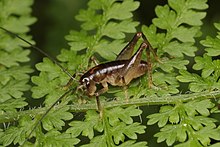Anderus
| Anderus | |
|---|---|

| |
| Anderus maculifrons | |
| Scientific classification | |
| Domain: | Eukaryota |
| Kingdom: | Animalia |
| Phylum: | Arthropoda |
| Class: | Insecta |
| Order: | Orthoptera |
| Suborder: | Ensifera |
| Family: | Anostostomatidae |
| Genus: | Anderus Trewick, Taylor-Smith & Morgan-Richards, 2024 |
| Type species | |
| Hemiandrus brucei Taylor-Smith et al., 2016 | |
| Species[1] | |
| Synonyms | |
|
Zealandosandrus Salmon, 1950 Hemiandrus Ander, 1938 | |
Anderus is a genus of forest insects in the family Anostostomatidae (wētā). All Anderus species are nocturnal, and hide in burrows during the day.[2] In New Zealand they are known as ground wētā due to their burrowing lifestyle.[3] Ground wētā adults are smaller than other types of wētā, and females of all Anderus species have long ovipositors.[4]
Taxonomy
The genus Anderus was named for the Swedish entomologist Kjell Ander in 2024.[4] Six species previously in the genus Hemiandrus were shown to be sister the Australian winged species Transaevum laudatum,[5][2] based on analysis of DNA sequences.[4] In the genus Anderus there are six described species and at least one undescribed species from Rakiura/Stewart Island.
Morphology

The genus Anderus includes the smallest wētā species, with adult individual body size no more than 7 millimetres,[2] and weighing less than a gram.[6] These wētā have no tympanum, and instead are able to detect sound through their cuticle, which is adaptive for their underground lifestyle.[3] Species in the genus Anderus can be distinguished from other New Zealand ground wētā (Hemiandrus) using the covering of short fine setae over the whole of the surface of segment 4 of their maxillary palps.[4]
Ecology
Ground wētā seal the entrance of their burrow during the day with a soil plug or door so that their burrow is concealed.[7] The diet of only two species is know; A. maculifrons and A. nox are carnivorous[8]
Several ground wētā species have been recorded drumming, despite lacking the tympanum 'ears' present in other wētā genera. The sounds produced are inaudible to humans and is detected through the cuticle.[3][9]
The species of Anderus are eaten by native bird species such as robins, saddlebacks[10] kiwi,[11] but also by introduced species such as mice,[12] stoats,[13] cats,[14] and hedgehogs.[15] Most species are common and widespread in native forests, and are not thought to be endangered (as per the New Zealand Department of Conservation).[16]
Distribution
This genus are found throughout the North and South Island, and even on some of the offshore islands of New Zealand.[2] They are found in lowland forests.[7]
Species
- Anderus brucei (Taylor-Smith, Trewick & Morgan-Richards, 2016)
- Anderus fiordensis (Salmon, 1950)
- Anderus luna (Taylor-Smith, Trewick & Morgan-Richards, 2016)
- Anderus maculifrons (Walker, 1869)
- Anderus nox (Taylor-Smith, Trewick & Morgan-Richards, 2016)
- Anderus subantarcticus (Salmon, 1950)
References
- ^ Citizen science observations for Anderus at iNaturalist
- ^ a b c d Taylor-Smith, B. L.; Trewick, S. A.; Morgan-Richards, M. (2016). "Three new ground wētā species and a redescription of". New Zealand Journal of Zoology. 43 (4): 363–383. doi:10.1080/03014223.2016.1205109. S2CID 88565199.
- ^ a b c Strauß, J.; Lomas, K.; Field, L. H. (2017). "The complex tibial organ of the New Zealand ground weta: sensory adaptations for vibrational signal detection". Scientific Reports. 7 (1): 2031. Bibcode:2017NatSR...7.2031S. doi:10.1038/s41598-017-02132-1. PMC 5435688. PMID 28515484.
- ^ a b c d Trewick, Steven A.; Taylor-Smith, Briar L.; Morgan-Richards, Mary (2024). "Wētā Aotearoa—Polyphyly of the New Zealand Anostostomatidae (Insecta: Orthoptera)". Insects. 15 (10): 787. doi:10.3390/insects15100787. ISSN 2075-4450. PMC 11508991.
- ^ Johns, P. M. (1997). "The Gondwanaland Weta: Family Anostostomatidae (Formerly in Stenopelmatidae, Henicidae or Mimnermidae): Nomenclatural Problems, World Checklist, New Genera and Species". Journal of Orthoptera Research (6): 125–138. doi:10.2307/3503546. JSTOR 3503546.
- ^ Chappell, E. M.; Webb, D. S.; Tonkin, J. D. (2014). "Notes on sexual size dimorphism, sex ratio and movements of adult ground weta (Walker) (Orthoptera: Anostostomatidae)". New Zealand Entomologist. 37 (2): 83–92. doi:10.1080/00779962.2013.856377. S2CID 4814697.
- ^ a b Taylor Smith, B. L.; Morgan-Richards, M.; Trewick, S. A. (2013). "New Zealand ground wētā (Anostostomatidae: ): descriptions of two species with notes on their biology". New Zealand Journal of Zoology. 40 (4): 314–329. doi:10.1080/03014223.2013.804422.
- ^ Cary, P. R. L. (1983). "Diet of the ground weta (Orthoptera: Stenopelmatidae)". New Zealand Journal of Zoology. 10 (3): 295–297. doi:10.1080/03014223.1983.10423918.
- ^ "Meet Bruce, he's a musician". New Zealand Geographic. Retrieved 2023-05-02.
- ^ Pierre, J. P. (2000). "Foraging behaviour and diet of a reintroduced population of the South Island Saddleback (Philesturnus carunculatus carunculatus)" (PDF). Notornis. 47: 7–12.
- ^ Colbourne, R.; Baird, K.; Jolly, J. (1990). "Relationship between invertebrates eaten by little spotted kiwi, , and their availability on Kapiti Island, New Zealand". New Zealand Journal of Zoology. 17 (4): 533–542. doi:10.1080/03014223.1990.10422951.
- ^ Wilson, D. J.; Lee, W. G. (2010). "Primary and secondary resource pulses in an alpine ecosystem: snow tussock grass ( spp.) flowering and house mouse ( ) populations in New Zealand". Wildlife Research. 37 (2): 89. doi:10.1071/WR09118.
- ^ Smith, D. H. V.; Jamieson, I. G.; Peach, R. M. E. (2005). "Importance of ground weta (Hemiandrus spp.) in stoat (Mustela erminea) diet in small montane valleys and alpine grasslands". New Zealand Journal of Ecology. 29 (2): 207–214. JSTOR 24058176.
- ^ Pascoe, Amelia (1995). "The effects of vegetation removal on rabbits (Oryctolagus cuniculus) and small mammalian predators in braided riverbeds of the Mackenzie Basin" (PDF). University of Otago.
- ^ Jones, C.; Moss, K.; Sanders, M. (2005). "Diet of hedgehogs (Erinaceus europaeus) in the upper Waitaki Basin, New Zealand: Implications for conservation". New Zealand Journal of Ecology. 29 (1): 29–35. JSTOR 24056190.
- ^ Johns, P. M. (2001). Distribution and conservation status of ground weta, Hemiandrus species (Orthoptera: Anastostomatidae) (PDF). Wellington, New Zealand: Department of Conservation. Retrieved 12 June 2018.
